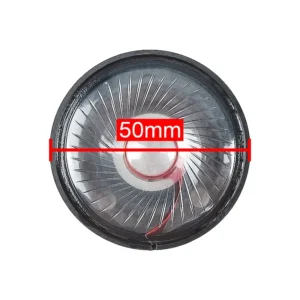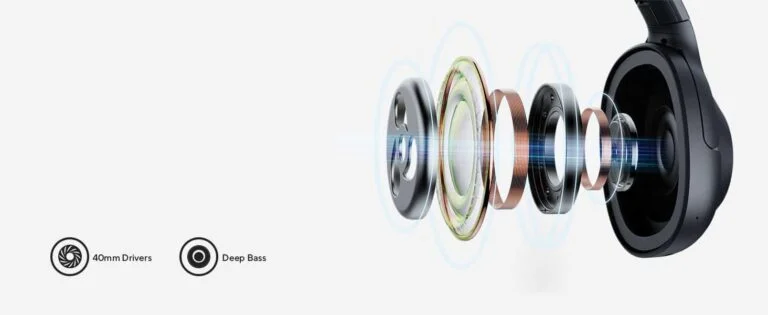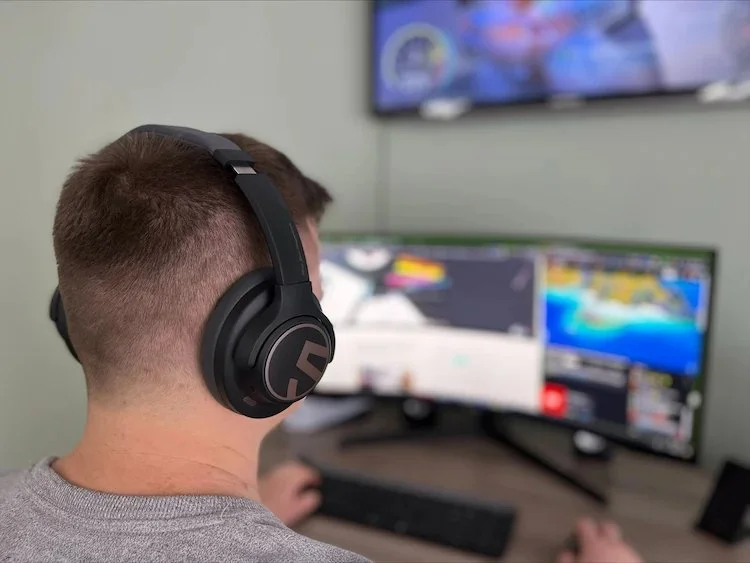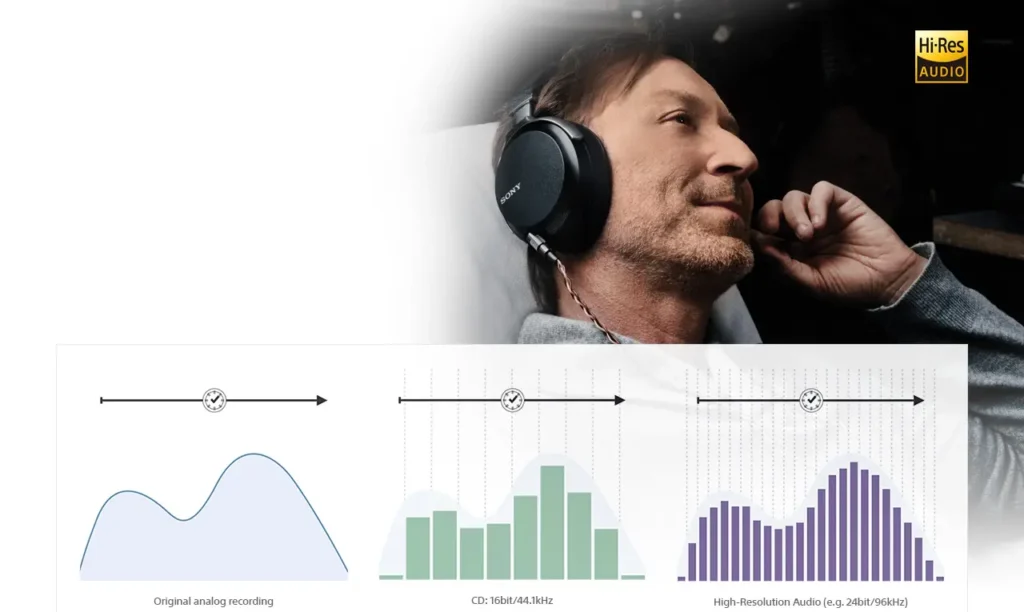When choosing headphones, the size of the driver often comes up as a key specification. Drivers are the core components that produce sound in headphones. Among the many options available, 50mm headphone drivers have become a favorite for those seeking powerful and immersive audio experiences.
But what does “50mm drivers” mean, and how do they stack up against smaller alternatives like 40mm drivers? In this guide, we’ll break down everything you need to know about 50mm drivers, their advantages, and whether they’re right for you. Read our guide on What is Dolby Atmos for Headphones?.
Table of Contents
What Are 50mm Drivers in Headphones?
The term “50mm drivers” refers to the diameter of the driver, measured in millimeters. Drivers are small speaker-like components inside the headphones that convert electrical signals into sound.

The 50mm measurement indicates the size of the diaphragm the part of the driver that vibrates to produce sound. Larger diaphragms generally allow for better bass response and a fuller soundstage.
How Do 50mm Drivers Work?
Drivers function by moving air to create sound waves. A larger driver, like a 50mm one, can move more air, which results in deeper bass and louder overall volume. Read our guide What is NC in Headphones?.

This makes them ideal for music genres like EDM, hip-hop, and rock, where bass and volume are key components of the listening experience.
Key Features of 50mm Drivers
- Enhanced Bass Performance: Larger diaphragms deliver stronger, more resonant bass.
- Wider Soundstage: Ideal for immersive listening experiences, whether you’re gaming or enjoying orchestral music.
- Higher Volume Output: Larger drivers can produce louder sound with less distortion.
- Versatile Application: Suitable for gaming, music production, and casual listening.
40mm vs. 50mm Drivers: What’s the Difference?

Choosing between 40mm and 50mm drivers often depends on your specific needs. Here’s a quick comparison:
| Feature | 40mm Drivers | 50mm Drivers |
|---|---|---|
| Bass Response | Moderate | Strong and punchy |
| Soundstage | Narrower | Wider and more immersive |
| Volume Output | Lower | Higher with minimal distortion |
| Portability | Compact and lightweight | Slightly bulkier |
| Best For | General listening and travel | Gaming, music production, bass-heavy genres |
Why Choose 50mm Headphone Drivers?
Superior Bass and Audio Depth
One of the standout features of 50mm drivers is their ability to produce deep, powerful bass that adds an extra layer of richness to your audio. These drivers excel in reproducing low frequencies, making them ideal for bass-heavy genres like EDM, hip-hop, and rock. Read our guide on Bluetooth 5.4.

The larger diaphragm size allows these drivers to move more air, creating a fuller and more impactful sound. Whether you’re enjoying your favorite tracks or watching an action-packed movie, the bass produced by 50mm drivers ensures that you feel every beat and rumble in unparalleled detail.
Bass enthusiasts and gamers alike appreciate the heightened realism and immersive quality that these drivers bring to the listening experience.
Enhanced Gaming Experience
For gamers, 50mm drivers are a game-changer, providing a distinct competitive advantage through exceptional audio clarity and spatial awareness. With their wider soundstage, these drivers allow you to distinguish between subtle in-game cues, such as enemy footsteps or distant gunfire, with remarkable precision.

This level of detail enhances both your performance in competitive games and your overall immersion in story-driven titles. The drivers also deliver dynamic and realistic audio effects, making explosions, ambient noises, and character dialogues more engaging.
Whether you’re playing a first-person shooter or an open-world adventure, 50mm drivers make the gaming experience truly cinematic and lifelike.
Versatility Across Devices
50mm drivers are highly versatile, making them compatible with a variety of audio sources and use cases. They work seamlessly with smartphones for casual listening, gaming consoles for immersive gameplay, and professional audio equipment for precise sound monitoring.

The ability of these drivers to handle high-resolution audio ensures that they perform well across different platforms and applications. Moreover, they pair exceptionally well with amplifiers and DACs, unlocking their full potential in terms of sound quality.
Whether you’re a casual listener or an audiophile, 50mm drivers adapt effortlessly to your audio setup, delivering consistent and impressive performance.
Popular Headphones with 50mm Drivers
Here are some top models featuring 50mm drivers and their key attributes:
| Headphone Model | Key Features | Best For |
|---|---|---|
| Audio-Technica ATH-M50x | Studio-quality sound, excellent bass | Music production, casual listening |
| HyperX Cloud Alpha | Dual-chamber drivers for crisp audio | Gaming |
| Sony MDR-7506 | Flat response for accurate sound reproduction | Professional use |
| Beyerdynamic DT 770 PRO | Exceptional sound isolation and bass accuracy | Studio monitoring |
Do Bigger Drivers Always Mean Better Sound?
While 50mm drivers excel in bass and soundstage, the size alone doesn’t guarantee better sound quality. Other factors such as driver material, housing design, and tuning play significant roles. For example, a well-tuned 40mm driver can outperform a poorly designed 50mm driver in terms of clarity and balance.
What Does 50mm Drivers Mean for Everyday Use?
For Music Lovers
50mm drivers are a dream come true for music enthusiasts, delivering a rich, immersive listening experience with unparalleled sound depth. The powerful bass response brings life to bass-heavy genres like EDM, hip-hop, and rock, ensuring every beat resonates with clarity and impact.

These drivers also excel in handling complex compositions, offering a balanced blend of lows, mids, and highs for genres like classical or jazz. Whether you’re tuning in to pump yourself up or unwind with soothing melodies, 50mm drivers provide a full-bodied sound that captures every nuance of your favorite tracks.
For Gamers
Gaming with 50mm drivers takes the experience to an entirely new level, offering a competitive edge with their expansive soundstage and directional audio capabilities. You’ll be able to hear the faintest enemy footsteps, distant gunfire, or even subtle environmental sounds, giving you the upper hand in intense matches.

The immersive audio quality transforms not just competitive gameplay but also single-player adventures, where cinematic soundtracks and atmospheric effects come alive. Whether you’re exploring a vast open world or engaging in a high-stakes battle, 50mm drivers ensure that every sound detail is clear and precise, enhancing your focus and enjoyment.
For Professionals
Professionals like audio engineers and music producers will appreciate the precise sound reproduction and dynamic range offered by 50mm drivers. These drivers provide an accurate and balanced sound profile, making them invaluable tools for critical tasks such as mixing, mastering, and sound monitoring.

The large diaphragm ensures that even the subtlest details in audio recordings are captured and conveyed with accuracy. Whether you’re working in a studio or on the go, 50mm drivers are a reliable choice for achieving professional-grade sound quality without missing a beat.
Conclusion
50mm drivers offer incredible bass performance, wider soundstage, and high volume output, making them ideal for gaming, music production, and bass-heavy genres.

While they might not always be the best choice for portability or balanced sound, their advantages are undeniable for those seeking immersive audio experiences. If you’re on the hunt for headphones that deliver impactful sound and versatility, 50mm drivers could be your perfect match.
Ready to experience the power of 50mm headphone drivers? Choose a pair that aligns with your lifestyle and prepare to elevate your audio journey.
FAQ
What is 50mm drivers in headphones?
50mm drivers refer to the size of the diaphragm within the headphones. Larger diaphragms produce stronger bass and a wider soundstage.
What does 50mm drivers mean?
This means the driver’s diameter is 50mm, allowing for deeper bass and louder sound compared to smaller drivers.
Are 50mm drivers better than 40mm?
Not necessarily. While 50mm drivers excel in bass and soundstage, 40mm drivers can deliver better clarity and balance in some cases.
Do 50mm drivers require amplifiers?
Not always. However, pairing them with an amplifier can enhance their performance, especially in professional or gaming setups.
Are 50mm drivers good for casual listening?
Yes, they offer an engaging and immersive listening experience, particularly for music genres that emphasize bass.